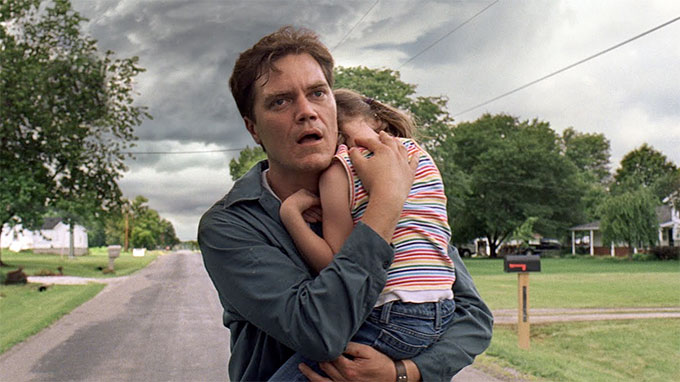Take Shelter
by George Sax

Curtis LaForche (Michael Shannon) is already becoming anxiously puzzled and disquieted as Jeff Nichols’s Take Shelter begins. In the very first scene, he sees and feels a thickened, oily rain falling on his driveway from menacing skies. Soon, he’s tormented by sleep-invading dreams of his docile pet dog suddenly turning into a savage killer and unidentified intruders trying to break into his house as he cowers inside with his small daughter. Sometimes he sees alarming giant storm formations in the skies and dense swarms of black birds coming together above him.
Nichols gives us an ostensibly and reassuringly normal, even pedestrian family: Curtis, his wife Samantha (Jessica Chastain), and six-year-old deaf daughter Hannah, and the expected mundane routines and challenges of a small-town, Ohio working-class family. And he subtly works to undermine this recognizably quotidian setting.
Curtis’s tension and disorientation don’t escape Samantha’s notice, but he brushes off her sympathetic concerns. We learn that there’s a history of mental illness in his family, and Curtis, who otherwise is a levelheaded, resolutely responsible husband and parent, is afraid of his dreams and weirdly ominous visions and experiences. (Nichols doesn’t allow us to clearly distinguish among these and between the dreamt and the “real,” perhaps to draw us in and get us to share his protagonist’s predicament.) He steadily invests the seemingly unremarkable flat summer landscape of southern Ohio with a difficult-to-pin-down menace, as if Curtis’s visions and fear were slowly affecting not only his mind but his environment.
For the most part, the writer-director builds things gradually, keeping a contrast between Curtis’s turmoil and apprehension and life around him, until his estrangement from his patient, practical-minded wife and his community become unavoidably obvious.
One popular take on this movie has its narrative operating metaphorically, implicitly alluding to recent American social and economic upheavals. This may well be the spirit with which Nichols intended to infuse his picture, but he’s given us another option—deliberately or not—with a tonally discordant scene at a neighborhood supper and the final scene, where Take Shelter introduces a Twilight Zone-style turnaround.
Take Shelter may be construed as a social parable, but it allows for a more literal meaning to be imposed. Nichols and his picture can seem just a little at odds with themselves.
Watch the trailer for Take Shelter
blog comments powered by Disqus
|
Issue Navigation> Issue Index > v10n44 (week of Thursday, November 3) > Film Reviews > Take Shelter This Week's Issue • Artvoice Daily • Artvoice TV • Events Calendar • Classifieds |









 Current Issue
Current Issue